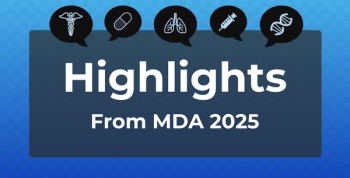
Insights Into Pulmonary Fibrosis Pathogenesis, Treatments, and the Potential Role of Traditional Chinese Medicine
Key Takeaways
- PF pathogenesis involves alveolar epithelial cell injury, profibrotic mediators, and dysregulated non-coding RNAs, complicating disease management.
- Current treatments, including pirfenidone and nintedanib, slow disease progression but do not reverse fibrosis, with lung transplantation as the only curative option.
From alveolar injury to extracellular matrix accumulation, the complex biology of pulmonary fibrosis is being unraveled alongside explorations of both Western and traditional Chinese therapies.
PF, considered the end stage of interstitial lung disease, is marked by fibroblast proliferation and extensive extracellular matrix (ECM) deposition that leads to irreversible scarring and significant loss of lung function. As the authors note, “the structural changes caused by PF are irreversible, and no existing therapeutic agent has proven to effectively stop the progression of the disease.”
The review first delves into the multifactorial mechanisms underlying PF. Injury to alveolar epithelial cells (AECs), particularly type II AECs, is now recognized as a major factor in the pathogenesis of fibrosis. These cells show increased apoptosis, senescence, abnormal differentiation, and impaired regeneration, driven by telomere shortening, mitochondrial and endoplasmic reticulum (ER) stress, autophagy, matrix metalloproteinase (MMP) activity, epithelial–mesenchymal transition (EMT), and dysregulated Wnt signaling.
Profibrotic mediators also play pivotal roles. TGF-β1, in particular, is identified as a central driver of fibrosis, promoting EMT, myofibroblast differentiation, ECM accumulation, and direct tissue injury. Other mediators, including connective tissue growth factor (CTGF), platelet-derived growth factor (PDGF), and vascular endothelial growth factor (VEGF), are implicated as well. Notably, the review points out VEGF’s complex and sometimes contradictory role, with both elevated and diminished levels linked to disease progression.
Beyond these well-characterized cellular and molecular pathways, the authors explore the emerging significance of non-coding RNAs. They describe growing evidence that dysregulated microRNAs (miRNAs) and circular RNAs (circRNAs) contribute to disease pathogenesis, noting that “research has become increasingly popular” in this area. Specific miRNAs, such as the upregulation of miR-21 and miR-155 and the downregulation of miR-26α, miR-29, miR-149, and miR-101, appear to exacerbate fibrosis. Because “the expression profile of miRNAs also changes with the pathological status and disease progression,” the authors suggest serum miRNA signatures may one day aid in early diagnosis, though further research is needed to validate their clinical reliability.
Diagnosis, they affirm, still relies on a comprehensive assessment combining clinical presentation, high-resolution computed tomography (HRCT), and histopathologic evaluation. Lung biopsy remains the gold standard when HRCT findings are inconclusive.
Therapeutic options remain limited, with lung transplantation being the only curative treatment. However, access is limited due to donor shortages and procedural risks. Currently approved antifibrotic agents, pirfenidone and nintedanib, have demonstrated modest efficacy in slowing disease progression and preserving lung function but fail to reverse fibrosis.2 They are often poorly tolerated and many patients discontinue therapy due to gastrointestinal adverse effects such as diarrhea and nausea.3 Other agents, such as N-acetylcysteine and antacids, offer limited or inconclusive benefit in large-scale trials.
Emerging therapeutic approaches, including gene therapy and immunomodulatory strategies, have drawn growing interest for the treatment of PF. Gene therapy, which aims to target fibrotic pathways at the molecular level, has shown encouraging results in early studies but remains experimental and requires further research and development before it can be widely adopted.4 Similarly, the authors highlight the close association between immune dysregulation and the pathogenesis of PF, which supports the use of immunomodulatory therapies across various subtypes. However, further research is needed to refine these treatment protocols and confirm their safety and efficacy.1
TCM receives particular attention as a potential adjunctive therapy. The authors detail both single-compound extracts and complex herbal formulas, providing preclinical evidence that TCM extracts and classic herbal formulas exert antifibrotic, anti-inflammatory, and antioxidant effects in animal models. These effects appear to converge on established molecular targets such as TGF-β1/Smads, PI3K/Akt, NF-κB-Snail signaling, oxidative stress pathways, and EMT, with the authors noting, “These signaling pathways are not independent but are interconnected and influenced by each other," adding, “Chinese medicine monomers, Chinese medicine compounds, and their active ingredients can effectively improve the symptoms of fibrosis in experimental animals and delay disease progression, showing good anti-inflammatory, antioxidant, and antifibrotic effects.” However, they call for more rigorous, multicenter clinical trials to solidify these promising preclinical findings.
The scientific understanding of PF is evolving, and this review highlights its complexity by detailing the intricate pathophysiological mechanisms driving disease progression. It also highlights the persistent need for more effective and better-tolerated therapies while exploring emerging treatment strategies, including the potential role of TCM as a part of a multimodal management approach.
References
- Cui D, Che X, An R,et al. Current understanding of pulmonary fibrosis: Pathogenesis, diagnosis, and therapeutic approaches. Can Respir J. 2025;3183241. doi: 10.1155/carj/3183241
- Kou M, Jiao Y, Li Z, Wei B, Li Y, Cai Y, Wei W. Real-world safety and effectiveness of pirfenidone and nintedanib in the treatment of idiopathic pulmonary fibrosis: a systematic review and meta-analysis. Eur J Clin Pharmacol. 2024;80(10):1445-1460. doi: 10.1007/s00228-024-03720-7
- Kou M, Jiao Y, Li Z, et al. Real-world safety and effectiveness of pirfenidone and nintedanib in the treatment of idiopathic pulmonary fibrosis: a systematic review and meta-analysis. Eur J Clin Pharmacol. 2024;80(10):1445-1460. doi: 10.1007/s00228-024-03720-7
- Bisserier M, Milara J, Abdeldjebbar Y, et al. AAV1.SERCA2a gene therapy reverses pulmonary fibrosis by blocking the STAT3/FOXM1 pathway and promoting the SNON/SKI axis. Mol Ther. 2020;28(2):394-410. doi: 10.1016/j.ymthe.2019.11.027
Newsletter
Stay ahead of policy, cost, and value—subscribe to AJMC for expert insights at the intersection of clinical care and health economics.








